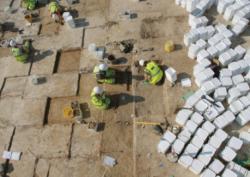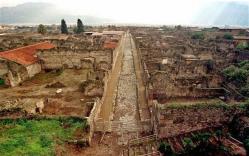INSTITUT SUPERIEUR D'ANTHROPOLOGIE
INSTITUTE OF ANTHROPOLOGY
ONLINE COURSES / COURS A DISTANCE
SPRING TERM : APRIL 2014
REGISTER NOW
INDE - Malayinkeezhu -The 'panchaloha' idols recovered from a well at Malayinkeezhu near here on March 17 belong to 13th century AD, according to archaeologists. The idols, worth Rs 10 crore, are likely to be sculpted by craftsmen of the later Chola dynasty, according to them. The idols, of Ganapati and Murugan, have been made of five metals -- gold, bronze, iron, silver and lead. "The idols contain a high percentage of gold. The method of mixing gold for idol-making was developed during the later Chola dynasty era that came after the 10th century. Moreover, the style of the sculpture looks similar to those of the then 'Tamizagam' which fell in the areas around modern-day Thanjavur," said archaeology department director G Premkumar. The department also found that parts of the fingers were missing from the idols. Police suspect that they might have been plucked out by thieves to ascertain the metal content in the idols. According to temple archaeology experts, the kind of panchaloha idols recovered from the well are sculptured using the lost-wax method. It is a method of making a hard wax cast by mixing paraffin wax, resin from the tree Damara Orientalis and groundnut oil.,,However, for making intricate parts of the idols like the eyes and nose, pure bee wax is used.
http://timesofindia.indiatimes.com/City/Thiruvananthapuram/Panchaloha-idols-belong-to-13-AD-Archaeologists/articleshow/33168176.cms
CHINE -  Loulan - Research Institute of Turpan in Xinjiang and Archaeology Research Center of JilinUniversity have reached an agreement on the joint study of the mummies found near theTurpan region. It' the first major study in the field of physical anthropology in Xinjiang. Turpan has unique natural environment featuring multi-winds, less rainfall, hightemperatures and dry air, which helps preserve the body of ancient people. The study selected more than 170 mummies from 2500 to 3000 years ago. Among themwere children, adolescents, middle aged and elderly. All the skeletons have been sent toArchaeology Research Center of Jilin University for further study.Of the skeletons to be studied, the mummy of a middle-aged man excavated in the AncientTombs of Shengjindian was with skull fracture and a prosthetic leg. Scientific researchfound the prosthetic leg was more than 2,300 years old, which is some hundred years olderthan the Roman Capua Leg – one of the earliest known prosthetic limbs in the world.
Loulan - Research Institute of Turpan in Xinjiang and Archaeology Research Center of JilinUniversity have reached an agreement on the joint study of the mummies found near theTurpan region. It' the first major study in the field of physical anthropology in Xinjiang. Turpan has unique natural environment featuring multi-winds, less rainfall, hightemperatures and dry air, which helps preserve the body of ancient people. The study selected more than 170 mummies from 2500 to 3000 years ago. Among themwere children, adolescents, middle aged and elderly. All the skeletons have been sent toArchaeology Research Center of Jilin University for further study.Of the skeletons to be studied, the mummy of a middle-aged man excavated in the AncientTombs of Shengjindian was with skull fracture and a prosthetic leg. Scientific researchfound the prosthetic leg was more than 2,300 years old, which is some hundred years olderthan the Roman Capua Leg – one of the earliest known prosthetic limbs in the world.
http://english.peopledaily.com.cn/98649/8587212.html
ROYAUME UNI –  Bexhill - A new exhibition at Bexhill Museum is showcasing the fruits of an archaeological dig being carried out as part of the Bexhill Hastings Link Road development.The display shows the archaeologist’s work in progress, where they are digging and what they have found so far.More than 70 flint scatters, some associated with possible structures, pits and hearths have so far been excavated, while the development of the landscape in later prehistory can be charted through the construction of a ring ditch, field boundaries and ditched trackways.;“A number of iron working sites of Late Iron Age to Roman date are being investigated with one terraced into a hillside and comprising well-preserved furnaces with ore-roasting pits, charcoal dumps and extensive slag heaps immediately adjacent to a possibly contemporary ditched enclosure of Roman date on the hill top above. This particular site was then occupied in the Early Medieval period and continues in use with the present day farmstead lying just to the south; an illustration of how the Link Road is providing us with an opportunity to understand change at a landscape scale.”
Bexhill - A new exhibition at Bexhill Museum is showcasing the fruits of an archaeological dig being carried out as part of the Bexhill Hastings Link Road development.The display shows the archaeologist’s work in progress, where they are digging and what they have found so far.More than 70 flint scatters, some associated with possible structures, pits and hearths have so far been excavated, while the development of the landscape in later prehistory can be charted through the construction of a ring ditch, field boundaries and ditched trackways.;“A number of iron working sites of Late Iron Age to Roman date are being investigated with one terraced into a hillside and comprising well-preserved furnaces with ore-roasting pits, charcoal dumps and extensive slag heaps immediately adjacent to a possibly contemporary ditched enclosure of Roman date on the hill top above. This particular site was then occupied in the Early Medieval period and continues in use with the present day farmstead lying just to the south; an illustration of how the Link Road is providing us with an opportunity to understand change at a landscape scale.”
http://www.ryeandbattleobserver.co.uk/news/local/link-road-excavation-added-to-the-archaeology-and-history-of-county-1-5979001
ITALIE –  Pompei - Ground sensors and satellites will be deployed in a new bid to keep the ancient Roman city of Pompeii from crumbling following a series of recent collapses at the sprawling and long-neglected site near Naples.The main aims are to assess “risks of hydrogeological instability” at the sprawling site, boost security and test the solidity of structures, as well as set up an early warning system to flag up possible collapses. Finmeccanica said the project would last three years and that the results of satellite monitoring of a network of wireless sensors installed around the Roman ruins would be made available via the Internet. Security guards will be supplied with special radio equipment as well as smartphone apps to improve communication that can pinpoint their position and the type of intervention required, Finmeccanica said.
Pompei - Ground sensors and satellites will be deployed in a new bid to keep the ancient Roman city of Pompeii from crumbling following a series of recent collapses at the sprawling and long-neglected site near Naples.The main aims are to assess “risks of hydrogeological instability” at the sprawling site, boost security and test the solidity of structures, as well as set up an early warning system to flag up possible collapses. Finmeccanica said the project would last three years and that the results of satellite monitoring of a network of wireless sensors installed around the Roman ruins would be made available via the Internet. Security guards will be supplied with special radio equipment as well as smartphone apps to improve communication that can pinpoint their position and the type of intervention required, Finmeccanica said.
http://archaeologynewsnetwork.blogspot.fr/2014/04/sensors-and-satellites-deployed-to-save.html#.Uz2mk_l_vVQ